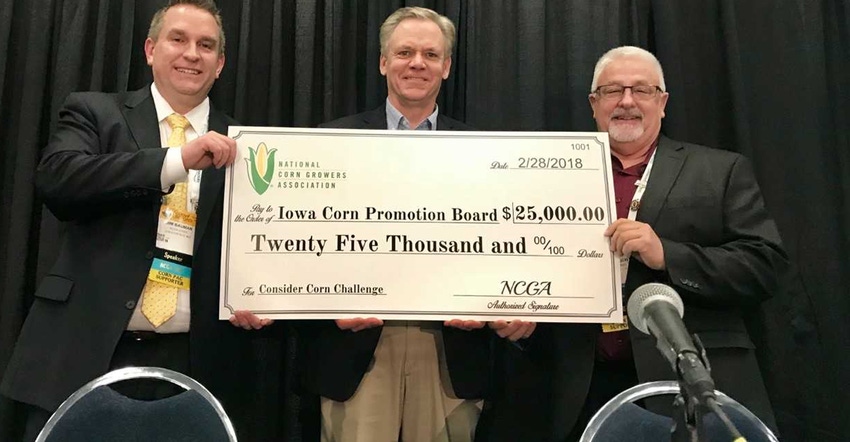March 9, 2018

A group of farmers and researchers at the Iowa Corn Promotion Board are on a quest to make a greener bioplastic ingredient that will stimulate the future of the corn industry.
Using Iowa Corn checkoff dollars to fund research into creating another demand for corn, ICPB holds U.S. patents on a proprietary production method using corn in the industrial manufacturing of a raw material, monoethylene glycol (MEG), to make bioplastic.
ICPB’s patented and pioneering process won the first Consider Corn Challenge, a global competition initiated by the National Corn Growers Association to identify new and innovative uses for field corn as a renewable feedstock in the production of sustainable chemicals with significant market demand.
“As more manufacturers seek ways to produce their products from greener materials with greater efficiency while reducing their dependence on fossil fuels, ICPB’s corn-based MEG has the potential to meet a vast and growing market,” says Pete Brecht, chair of Iowa Corn’s research and business development committee.
He adds, “By improving the manufacturing processes for bio-based materials, this method will continue to expand the renewable products market. Enhanced yield of corn-based MEG over competition makes this bio-based process more competitive with less waste than current bio-based MEG. This one switch to a more renewable material will reduce America’s dependence on foreign oil and improve the environmental footprint for hundreds of consumer products.”
MEG makes up 30% of bottles
MEG is an industrial chemical used in the manufacture of antifreeze, plastic bottles for water and soft drinks, and polyester clothes. Today, MEG makes up about 30% of bottles and polyester.
In 2016, 62 billion pounds of MEG were sold. It is predicted that global demand for MEG will grow at a 4% rate each year. If this 4% is captured by corn-based MEG, this could raise the demand for corn to an additional 94 million bushels a year.
“Patenting research that improves production efficiencies of corn-based bio-MEG helps us eliminate the need for petroleum-based ethylene derivatives by using a homegrown crop,” Brecht says. “By reducing the demand and reliance on fossil fuels, it will also contribute to environmental stewardship by taking carbon dioxide out of the atmosphere through corn production.”
Investing corn checkoff dollars
The traditional way to produce bio-MEG is through a conversion of sugarcane ethanol, usually sourced from Brazil, to ethylene; however, the majority of MEG still comes from oil. ICPB’s new process in development can eliminate these added costs of bio-MEG by going from cane sugar to MEG in one step. This new corn-based MEG would be considered a “drop-in chemical,” meaning it would leave the manufacturing process and the product unchanged aside from it being partially bio-based.
Investment of checkoff dollars in research and business development allows for a direct return on Iowa corn farmer investments. Consequently, ICPB research programs have continued to grow. ICPB research programs aim to find new and innovative uses of corn, such as plastics and industrial chemicals.
Source: Iowa Corn Growers Association
Contest highlights corn’s potential in bio-economy
Six new technologies that could change the way the public perceives corn were highlighted at the recent 2018 Commodity Classic. The six were winners in the first-ever “Consider Corn Challenge,” a contest hosted by the National Corn Growers Association.
More than 30 scientists and startup companies answered the global call to bring their best ideas focused on converting corn into bio-renewable chemicals. Contest entries reinforced the idea that corn can improve the environmental footprint of many products used by consumers, including plastic bottles, acrylics, solvents, fibers, packaging and coolants.
The contest generated 33 submissions from eight countries along with nearly 4,200 website visits from 82 countries. There were six winning projects, each receiving a $25,000 cash prize. NCGA will also explore opportunities to support contest entries throughout their development and commercialization.
The Iowa Corn Promotion Board was one of the top six winners, and received a $25,000 check for developing monoethylene glycol, a product that has a range of diverse applications from coolants and heat transfer fluid to packaging material. Today, many major consumer products groups are searching for ways to reduce their packaging’s environmental footprint, and Iowa Corn’s bio-renewable MEG may be the answer, says Bruce Peterson, chair of NCGA’s Feed, Food and Industrial Action Team.
“According to a USDA study in 2016, the U.S. bio-based products industry currently creates 4.2 million jobs and generates $393 billion in value added contributions to our economy, but there are many exciting market segments yet to be explored,” says Jim Bauman, NCGA director of market development.
Source: National Corn Growers Association
You May Also Like




